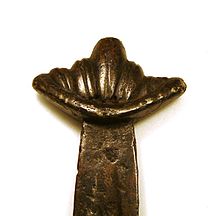| Cawood sword | |
|---|---|
 The Cawood sword The Cawood sword | |
| Period/culture | Medieval |
| Discovered | late 19th century River Ouse, near Cawood, North Yorkshire |
| Present location | Medieval Gallery, Yorkshire Museum, York |

The Cawood sword is a medieval sword discovered in the River Ouse near Cawood in North Yorkshire in the late 19th century. The blade is of Oakeshott type XII and has inscriptions on both sides. It most likely dates to the early 12th century.
Significance
The sword is notable as the best-preserved specimen of a small group of medieval swords with a type M pommel in the typology of Oakeshott (1964). This type of pommel is an apparently specifically British derivation of the Viking Age multi-lobed pommel. It is often found on tomb effigies of the mid 13th to mid 14th century in southern Scotland and northern England, but it may have been in existence since the 11th century.
A very similar sword, likely from the same workshop, was discovered in Norway in 1888 while railway work was being conducted on farmland at Korsoygaden in Stange municipality, Hedmarken district.
Dating
The question of the date of these swords is of some importance for the absolute chronology of the development of sword morphology in medieval Europe. In 1964, Oakeshott stated that while both swords were "long believed" to date to the late 11th or early 12th century, suggested by the "Viking sword"-type pommel and the runic inscription on the Korsoygaden sword, they could not possibly predate the mid 13th century because of the style of the Cawood sword's inscriptions, and because the pommel type was not in fact in "Viking Age" style, but in a "late" British derivation of pommel shapes of the Viking Age. However, in 1991, Oakeshott revisited this opinion based on the style of the runic inscription on the Korsoygaden sword. The 12th-century date for both swords is based on this argument. This, i.e. the combined evidence from the Cawood and the Korsoygaden swords, are of "extreme importance" for the dating of swords and blade inscriptions of the 11th to 12th centuries. Oakeshott (1991) presents a group of eight swords, some of which were previously dated to c. 1300, which based on close morphological parallels to these swords must be reassigned to the period of c. 1000–1120. Oakeshott's date for the Cawood sword itself is now c. 1100–1150. This has consequences for the dating of medieval sword blade inscriptions, as the inscriptions on the Cawood blade are very typical of the "garbled" letter-group inscriptions on high medieval blades (tentatively transcribed as ✠NnRDIOnNnR✠ ⊕N[RSRDIGATON[I).
Ownership and display
The Cawood sword was kept at the Tower of London until the 1950s and then sold into private hands. It was again on display in The Age of Chivalry exhibition at Burlington House in 1987.
It was acquired by the Yorkshire Museum, York in December 2007. Since 2017 it has featured as one of the key objects in the exhibition 'Medieval York: Capital of the North'.
References
- Oakeshott (1964:97)
- "The Korsoygaden sword, long believed to date to be of late Viking date, is in fact a Type XII. The hilt is almost exactly the same shape as that of the Cawood sword (also a XII), which by the style of the inlaid inscriptions in its blade may be placed with some confidence within a period between perhaps 1240 and 1310. Certainly no earlier than the former. The runes on the Korsoygaden hilt might have been made at any time between 1000 and 1300 (not later). Thus, in spite of being found in a stone coffin with the remains of a circular shield, it seems likely that the Korsoygaden sword must be of c. 1240–1300, not of c. 1000." Oakeshott (1964:98).
- "the runes inscribed upon the bronze collars which once held the grip at top and bottom rather roughly incised in a rather 'home-made' style, have been positively dated as being no later than 1150 and unlikely to be much earlier than 1100. These datings have been made by two extremely eminent Runologists, Eric Moltke and O. Rygh, each independently corrobating the other's finding. On stylistic grounds and on the circumstances of its burial, Jan Petersen dated the sword to c. 1050" Oakeshott (1991:76)
- previously placed in the 13th century, this type of inscription is now widely recognized as popular throughout the 12th century, seamlessly connecting to the earlier Ulfberht inscriptions. In a single specimen, dated c. 1100, an "early medieval" Ulfberht inscription on one side of the blade has been found to coexist with a "high medieval" letter-group inscription on the other. Herrman, J. and Donat P. (eds.), Corpus archäologischer Quellen zur Frühgeschichte auf dem Gebiet der Deutschen Demokratischen Republik (7.-12. Jahrhundert), Akademie-Verlag, Berlin (1985), p. 376.
- "Rescued relic". BBC News. 19 December 2007. Retrieved 11 April 2016.
- "MEDIEVAL YORK: CAPITAL OF THE NORTH". Yorkshire Museum. Retrieved 4 October 2018.
- Ewart Oakeshott, The Sword in the Age of Chivalry (1964).
- Ewart Oakeshott, Records of the Medieval Sword (1991), 76–81.
External links
- The Cawood Sword at the History of York project
- The Cawood Sword: The Finest Viking Sword Ever Found
- Yorkshire Museum and Gardens (18 December 2007). "One thousand year old Viking sword comes home to Yorkshire". Archived from the original on 29 June 2008. Retrieved 21 December 2007.
- Patrick Kelly, Spotlight: Oakeshott Type XII Swords